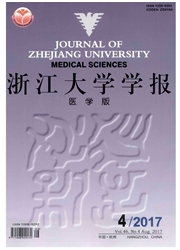

 中文摘要:
中文摘要:
目的:研究氨基胍对丙酮醛加重脑微血管内皮细胞(HBMEC)缺糖缺氧损伤的保护作用。方法:在培养的HBMEC上,利用丙酮醛加重缺糖缺氧诱导的损伤,通过MTT检测细胞活力,LDH释放检测细胞死亡,流式细胞仪检测细胞凋亡,Western-blot检测晚期糖基化终产物的形成,观察氨基胍的作用和机制。结果:丙酮醛呈浓度依赖地诱导细胞损伤,在2 mmol/L时细胞的存活率为56.1%,而丙酮醛合并缺糖缺氧后,细胞的损伤率增加到90.0%。氨基胍(1 mmol/L)能抑制丙酮醛和缺糖缺氧诱导的LDH释放和AnnexinV/PI的形成。进一步研究发现氨基胍能抑制丙酮醛和缺糖缺氧诱导晚期糖基化终产物的形成。结论:氨基胍对丙酮醛加重HBMEC的缺糖缺氧损伤具有保护作用,这可能与其抗糖基化作用有关。
 英文摘要:
英文摘要:
Objective: To evaluate the effects of aminguanidine on methylglyoxal-mediated oxygen- glucose deprivation (OGD) injury in the cultured human brain microvascular endothelial cells (HBMEC). Methods: Cultured HBMEC cells were pretreated with methylglyoxal before oxygen-glucosedeprivation injury. Cell vitality was determined by MTr method, cell mortality was assessed by LDH release method, cell apoptosis was examined by AnnexinV/PI formation method, and the advanced glycation end products (AGEs) were detected by Western-blot. Results: Methylglyoxal induced HBMEC injury in a dose-dependent manner. At 2 mmoL/L of methylglyoxa, the cell viability was 56.1% ; when methylglyoxa-pretreated cells exposed to oxygen-glucose deprivation, the cell inhibition rate was 90. 0%. Aminguanidine (1 mmol/L) inhibited methylglyoxa and OGD induced LDH release and AnnexinV/PI formation. Furthermore, aminguanidine (1 retool/L) also decreased advanced glycation end products ( AGEs ) formation induced by methylglyoxal and oxygen-glucose deprivation. Conclusion: Aminguanidine protected methylglyoxal mediated-oxygen-glucose deprivation injury in the cultured HBMEC ,which may be associated with anti-glycation activity.
 同期刊论文项目
同期刊论文项目
 同项目期刊论文
同项目期刊论文
 Dexmedetomidine protects against oxygen-glucose deprivation-induced injury through the I2 imidazolin
Dexmedetomidine protects against oxygen-glucose deprivation-induced injury through the I2 imidazolin A rat model of studying tissue-type plasminogen activator thrombolysis in ischemic stroke with diabe
A rat model of studying tissue-type plasminogen activator thrombolysis in ischemic stroke with diabe Efficacy of rifaximin in prevention of traveler diarrhea: a meta-analysis of randomized, double-blin
Efficacy of rifaximin in prevention of traveler diarrhea: a meta-analysis of randomized, double-blin Cerebral ischemia-reperfusion-induced autophagy protects against neuronal injury by mitochondrial cl
Cerebral ischemia-reperfusion-induced autophagy protects against neuronal injury by mitochondrial cl Hydroxysafflor yellow A protects methylglyoxal-induced injury in the cultured human brain microvascu
Hydroxysafflor yellow A protects methylglyoxal-induced injury in the cultured human brain microvascu Endoplasmic reticulum stress induced by tunicamycin and thapsigargin protects against transient isch
Endoplasmic reticulum stress induced by tunicamycin and thapsigargin protects against transient isch Dysfunction of annexin A2 contributes to hyperglycaemia-induced loss of human endothelial cell surfa
Dysfunction of annexin A2 contributes to hyperglycaemia-induced loss of human endothelial cell surfa Edaravone Protected Human Brain Microvascular Endothelial Cells from Methylglyoxal-Induced Injury by
Edaravone Protected Human Brain Microvascular Endothelial Cells from Methylglyoxal-Induced Injury by Dosing practice of low molecular weight heparins and its efficacy and safety in cardiovascular inpat
Dosing practice of low molecular weight heparins and its efficacy and safety in cardiovascular inpat Inhibitory effects of hydroxysafflor yellow A on the formation of advanced glycation end products in
Inhibitory effects of hydroxysafflor yellow A on the formation of advanced glycation end products in 期刊信息
期刊信息
